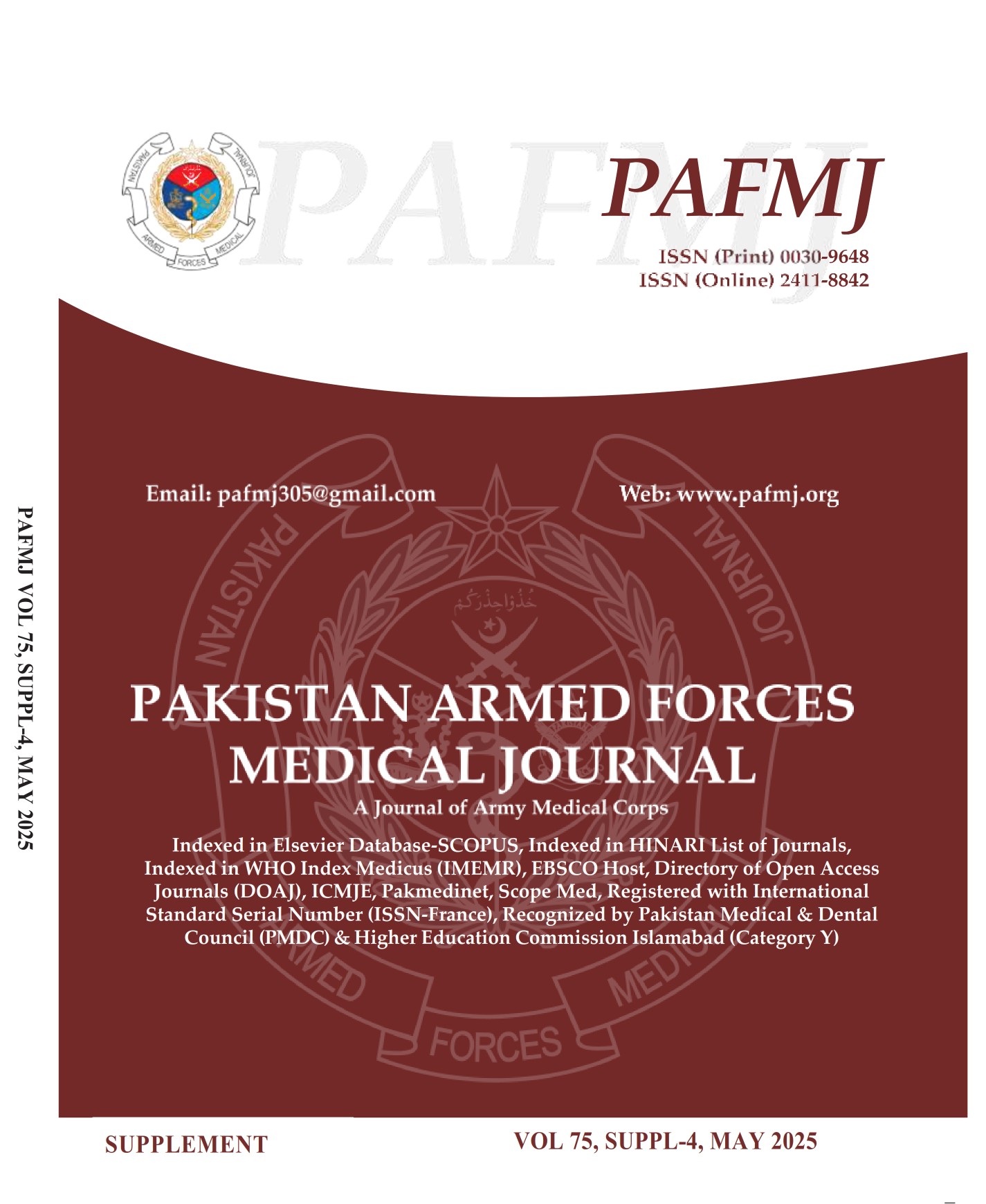Correlation of C- Reactive Protein (CRP) and Lipid Profile Among Patients of Ischemic Heart Disease (IHD) and Non-Ischemic Heart Disease Patients
DOI:
https://doi.org/10.51253/pafmj.v75iSUPPL-4.11949Keywords:
Cholesterol, C - reactive protein, Dyslipidemia, Ischemic heart disease.Abstract
Objective: To determine correlation of C-reactive protein with lipid profile among patients of ischemic heart disease (IHD) and non-ischemic heart disease (non-IHD) and to determine association of CRP with dyslipidemia in IHD and non-IHD patients.
Place and Duration of Study: Combined Military Hospital, Bahawalpur Pakistan, from Apr 2023 to Dec 2023.
Study Design: Comparative cross sectional study.
Methodology: A total of 252 patients were enrolled in this study (159 patients of IHD and 93 non-IHD patients). Quantitative CRP and serum Lipid Profile were assayed on fully automated chemistry analyzer Cobas c501 by Roche®. Pearson correlation technique was applied to determine correlation. Chi square test was used to find any significant association between CRP and both IHD and non-IHD groups.
Results: Out of 252 patients, 159(63.1%) had IHD, while 93(36.9%) had no history of IHD. For IHD group mean of total cholesterol, triglycerides, LDL-cholesterol, HDL-cholesterol and CRP were 5.71±0.70 mmol/L, 2.48±0.79 mmol/L, 3.03±0.60 mmol/L, 1.11±0.25 mmol/L and 11.04±5.92 mg/L respectively. Pearson correlation coefficient (r) between CRP and total cholesterol, TG, LDL-cholesterol and HDL-cholesterol were 0.84, 0.46, 0.73 and -0.79 for IHD group, while these were 0.42, 0.02, 0.29 and - 0.38 respectively for non-IHD group. Strong association of CRP among IHD and Non-IHD groups with dyslipidemia was observed (p<0.001).
Conclusion: Positive correlation between CRP and total cholesterol, TG, LDL-cholesterol was observed in IHD group. Association between CRP and dyslipidemia is a significant finding in both ischemic and non-ischemic heart disease patients.
Downloads
References
Esposito K, Giugliano D. The metabolic syndrome and inflammation: association or causation? Nutr Metab Cardiovasc Dis 2004; 14(5): 228-32.
https://doi.org/10.1016/s0939-4753(04)80048-6
Kayapinar O, Ozde C, Kaya A. Relationship Between the Reciprocal Change in Inflammation-Related Biomarkers (Fibrinogen-to-Albumin and hsCRP-to-Albumin Ratios) and the Presence and Severity of Coronary Slow Flow. Clin Appl Thromb Hemost 2019; 25: 1076029619835383.
https://doi.org/10.1177/1076029619835383
Sproston NR, Ashworth JJ. Role of C-Reactive Protein at Sites of Inflammation and Infection. Front Immunol 2018; 9: 754.
https://doi.org/10.3389/fimmu.2018.00754
Xharra S, Gashi-Luci L, Xharra K, Veselaj F, Bicaj B, Sada F et al. Correlation of serum C-reactive protein, white blood count and neutrophil percentage with histopathology findings in acute appendicitis. World J Emerg Surg 2012; 7(1): 27.
https://doi.org/10.1186/1749-7922-7-27
Shen J, Ordovas JM. Impact of genetic and environmental factors on hsCRP concentrations and response to therapeutic agents. Clin Chem 2009; 55(2): 256-264.
https://doi.org/10.1373/clinchem.2008.117754
Cozlea DL, Farcas DM, Nagy A, Keresztesi AA, Tifrea R, Cozlea L et al. The impact of C reactive protein on global cardiovascular risk on patients with coronary artery disease. Curr Health Sci J 2013; 39(4): 225-231.
Fu Y, Wu Y and Liu E: C‑reactive protein and cardiovascular disease: From animal studies to the clinic (Review). Exp Ther Med 20: 1211-1219, 2020.
https://doi.org/10.3892/etm.2020.8840
Liu C, Li C. C-reactive protein and cardiovascular diseases: a synthesis of studies based on different designs, European Journal of Preventive Cardiology, Volume 30, Issue 15, October 2023, Pages 1593–1596.
https://doi.org/10.1093/eurjpc/zwad116
Lagrand WK, Visser CA, Hermens WT, Niessen HWM, Verheugt FWA, and Wolbink GJ et al. C-Reactive Protein as a Cardiovascular Risk Factor. Circulation. Vol 100, Issue 1, 6 July 1999; Pages 96-102. https://doi.org/10.1161/01.CIR.100.1.96
Kazmi T, Nagi MLF, Razzaq S, Hussnain S, Shahid N, and Athar U et al. Burden of noncommunicable diseases in Pakistan. East Mediterr Health J 2022; 28(11): 798–804.
https://doi.org/10.26719/emhj.22.083.
Hong N, Lin Y, Ye Z, Yang C, Huang Y, Duan Q et al. The relationship between dyslipidemia and inflammation among adults in east coast China: A cross-sectional study. Front Immunol 2022; 13: 937201.
https://doi.org/10.3389/fimmu.2022.937201
Hen X, Hou C, Yao L et al. Dietary inflammation index is associated with dyslipidemia: evidence from national health and nutrition examination survey, 1999–2019. Lipids Health Dis 22, 149 (2023). https://doi.org/10.1186/s12944-023-01914-z
Tietge, Uwe J.F.. Hyperlipidemia and cardiovascular disease: inflammation, dyslipidemia, and atherosclerosis. Current Opinion in Lipidology 25(1):p 94-95, February 2014.
https://doi.org/10.1097/MOL.0000000000000051
Bafei, S.E.C., Zhao, X., Chen, C. et al. Interactive effect of increased high sensitive C-reactive protein and dyslipidemia on cardiovascular diseases: a 12-year prospective cohort study. Lipids Health Dis 22, 95 (2023).
https://doi.org/10.1186/s12944-023-01836-w
Waheed P, Naveed AK, Farooq F. Levels of inflammatory markers and their correlation with dyslipidemia in diabetics. J Coll Physicians Surg Pak 2009; 19(4): 207-210.
Chianeh YR, Prabhu K, Bhat VR, Udupa P, Bagheri A, Baliga S et al. High-sensitive C-reactive protein levels in diabetes associated with dyslipidemia. Natl J Physiol Pharm Pharmacol 2016; 6(5): 480-483.
https://doi.org/10.5455/njppp.2016.6.0615715072016
Jeong H, Eun YH, Kim I, et al. C-reactive protein level as a marker for dyslipidemia, diabetes, and metabolic syndrome: results from the korean national health and nutrition examination survey. Annals of the Rheumatic Diseases 2019; 78: 2092.
Downloads
Published
Issue
Section
License
Copyright (c) 2025 Muhammad Shahzad Anwer, Usama Bin Khalid, Sara Khan, Shamshad Ali, Mohsin Hussain Nizamani, Rabia Saeed

This work is licensed under a Creative Commons Attribution-NonCommercial 4.0 International License.















